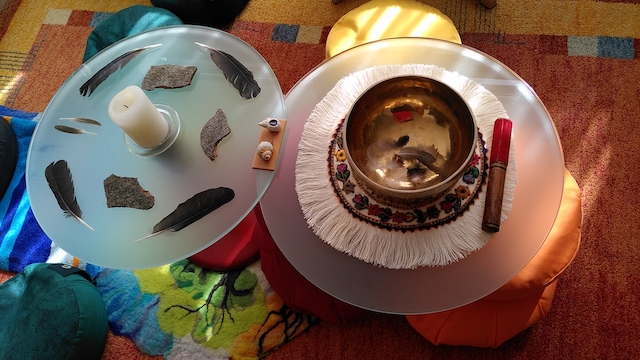We are hosting Council sessions to support our inquiry and practice and to weave community. This practice is rooted in ancient traditions of storytelling, and we experiment with bringing it into the context of our modern lives as human-researcher-practitioners.
A “Council” is an intentional space that we cultivate together, based on mindful presence, sharing stories, deep listening, witnessing, and confidentiality. We usually invite stories that are centered on a given theme, while sometimes new and unexpected directions can emerge.
We are looking forward to being with you in Council!
Form and Structure
The form of a Council is a virtual or real circle in which all participants are sitting in equal distance around a center on eye level. This includes the facilitators, who are taking an additional responsibility to hold the form and facilitate the flow. This setup and the agreement of confidentiality can support the group for a “deep dive” together.
A talking piece is passed around the circle, indicating whose turn it is to speak while all others are listening. In a virtual setting, this can be supported by opening and muting the microphone.
There are also some special forms of Council, such as a “fishbowl” or “spiral” setting.
Intentions
A Council is supported by the following intentions (or guidelines):
- Speak from the heart
- Listen from the heart
- Be lean of expression
- Be spontaneous
- Honor confidentiality(*)
- Speak what serves you, the circle, and the larger whole
(*) This intention is sometimes described as a “rule”. The shared commitment to neither tell nor comment on someone else’s story (both during and after a session) can support an atmosphere of trust that allows for deeper sharing during Council.
Flow
You can imagine the flow of a Council as follows:
- We remember the intentions of Council, e.g. by speaking them aloud.
- We do a grounding practice (breathing, silence, movement).
- We open the ceremony by inviting everyone to bring dedications, qualities, intentions to (in)form the “center” of the circle.
- We offer a prompt for everyone to check in.
- We offer a prompt for everyone to share stories.
- We invite witnessing of what was shared and received.
- We close the ceremony, e.g. with a gesture of movement or sound.
Preparing
We recommend that you take these preparations for our online time together in Council:
- Slow down. See if you can reduce the pace of your activities already before the session begins. Even just a few minutes can help.
- Arrive early. In our online Council gatherings, we “open doors” for your arrival within +/-5 minutes around the starting time, to create a safe container that can hold the energy of the circle.
- Minimize distractions. See that you can have a private space, stay in one place, and be undisturbed during our online time together. This also supports the whole group.
- Bring your talking piece. Optionally, you can choose a personal item that you can hold whenever it is your turn to speak.
Resources
Website: Ways of Council
Website: We Are Open Circle
Website: The Circle Way
Book: Jack Zimmermann and Virginia Coyle (2009). The Way of Council (2nd Edition). Bramble Books.
Book: Ann Linnea and Christina Baldwin (2010). The Circle Way – A Leader in Every Chair. Berrett-Koehler Publishers.
Book: Heather Plett (2020). The Art of Holding Space – A Practice of Love, Liberation, and Leadership. Page Two.
Book: David Bohm (2004). On Dialogue (2nd Edition). Routledge.
Video: The Power of Listening – An Ancient Practice for Our Future. Leon Berg at TEDxRedondoBeach (2013).
